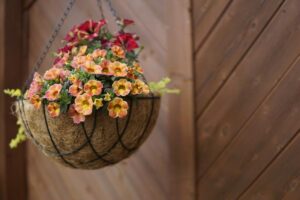In this guide, we’ll explore a selection of these shrubs, highlighting their beauty, unique characteristics, and ideal growing conditions.
Beautyberry (Callicarpa spp.)
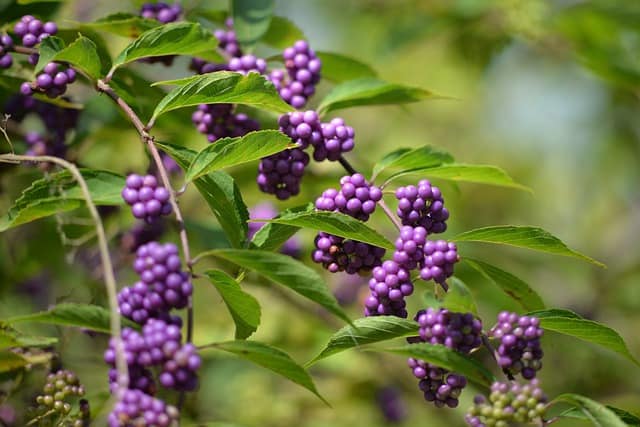
One of the most captivating shrubs in late summer and fall is the Beautyberry (Callicarpa spp.). Known for its clusters of vibrant purple berries, this standout is not just a pretty face. Beautyberries thrive in well-drained soils and can grow in partial to full sunlight, making them versatile for various landscape designs. They typically reach heights of 3 to 6 feet, providing a lovely backdrop for shorter perennials.
The foliage of the Beautyberry is a lovely green during the growing season, making it an attractive choice for garden beds. Once the autumn months roll around, the bright berries emerge, drawing in birds and other wildlife. Beautyberry can be pruned back in late winter to encourage new growth and maintain an attractive shape. Whether planted en masse or as a single specimen, Beautyberry adds a delightful pop of color that transforms a garden in the fall.
Butterfly Bush (Buddleia or Buddleja spp.)
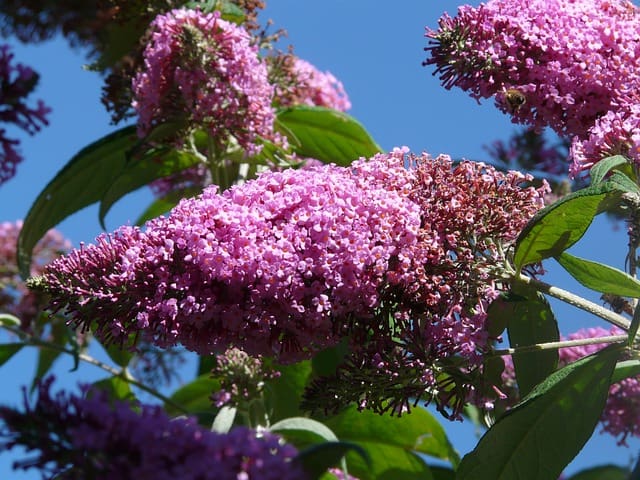
For gardeners looking to attract pollinators, the Butterfly Bush (Buddleia spp.) is a must-have. This fast-growing shrub is adored for its long, fragrant flower spikes that bloom from mid-summer to frost, creating a haven for butterflies, bees, and hummingbirds. The flowers vary in color from lavender to white, pink, and deep purple, providing a beautiful contrast against its green foliage.
Butterfly Bush prefers full sun and well-drained soil, thriving in various climates. It can reach heights of 4 to 12 feet, depending on the variety, and its growth can be controlled through pruning. Deadheading spent blooms encourages further flowering and helps maintain the shrub’s shape. Given its robust growth and striking appearance, the Butterfly Bush can be used as a specimen plant or massed for a stunning display that enhances any garden.
Chinese Fringe Flower (Loropetalum spp.)
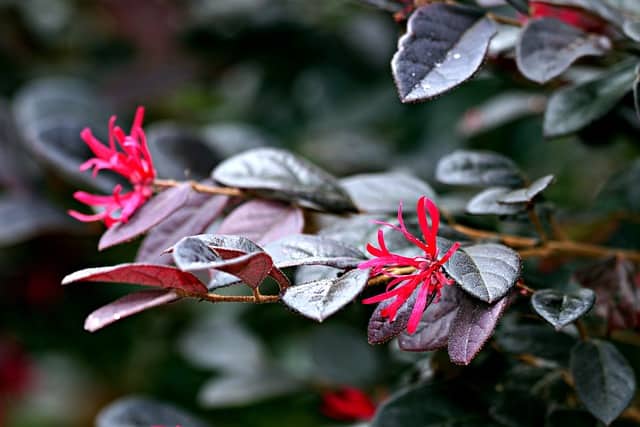
With its stunning, fringed flowers and rich purple foliage, the Chinese Fringe Flower (Loropetalum spp.) has become increasingly popular in modern landscapes. This evergreen shrub boasts unique blossoms that appear in shades of pink or white and bloom from early spring through summer. When planted in well-drained soil and full to partial sun, the Chinese Fringe Flower flourishes, typically reaching heights of 3 to 10 feet.
Not only is this shrub visually striking, but it also provides year-round interest with its vibrant foliage. The leaves transition from a deep burgundy in cooler months to fresh green as temperatures rise. This shrub is ideal for creating a colorful hedge, providing excellent coverage while serving as a backdrop for other flowering plants and ornamental grasses.
Cotoneaster (Cotoneaster spp.)

Cotoneaster is a versatile genus of flowering shrubs that vary significantly in size and form, but most bear lovely white to pink flowers in late spring. These blooms are followed by small red or orange berries that attract birds and provide additional visual interest throughout the fall and winter. Depending on the species, Cotoneaster can grow anywhere between 2 to 15 feet tall.
Most Cotoneaster varieties prefer full sun and are tolerant of a range of soil types, making them adaptable in various garden settings. Their creeping varieties can serve well as ground cover, while the larger types can provide excellent screening or backdrop. Easy to maintain, Cotoneaster can be pruned in late winter or early spring to maintain their shape and promote healthy new growth.
Elderberry (Sambucus spp.)
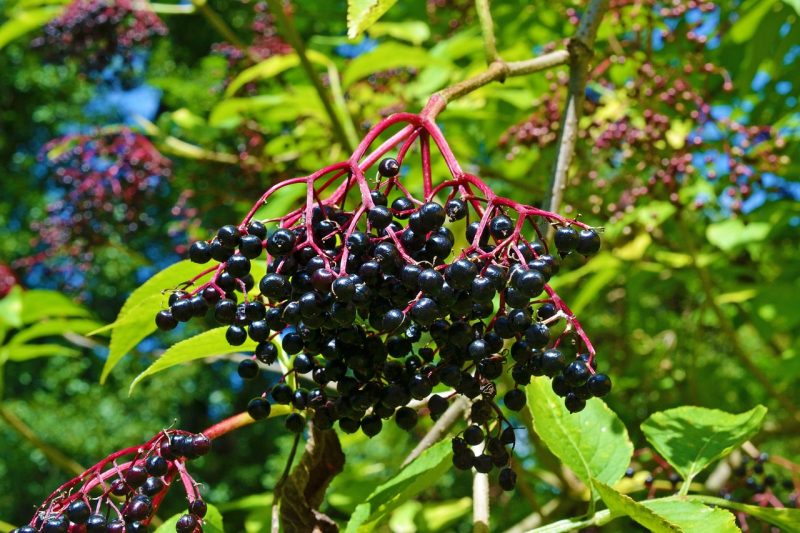
Elderberries (Sambucus spp.) are well-known for their delicious and nutritious berries, which can be harvested in the fall for making jams, jellies, and wine. These shrubs can grow quickly, reaching heights of 5 to 12 feet, and are not only loved for their edible fruit but also their stunning clusters of fragrant white or pink flowers in late spring.
Elderberry bushes thrive in well-drained soil, and while they prefer full sun, they can tolerate partial shade. The leaves are often compound and can add a lush look to any garden. Being a multi-stemmed shrub, elderberry can be pruned back in winter to encourage vigorous new growth in the spring. Besides their culinary uses, elderberries can attract a range of wildlife to your garden, providing nectar for pollinators and food for birds.
English Laurel (Prunus laurocerasus)
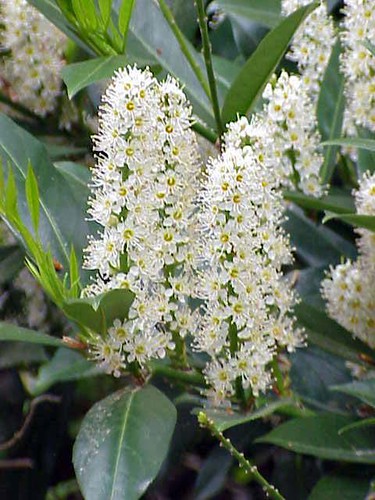
Often chosen for its dense evergreen foliage, the English Laurel (Prunus laurocerasus) is a superb choice for creating formal hedges or privacy screens. This fast-growing shrub showcases glossy, dark green leaves and produces small white flowers in spring, which often give way to black berries that attract birds.
Generally reaching heights of 6 to 10 feet, English Laurel is adaptable to a variety of soil types and can flourish in various light conditions, although it prefers partial shade. Given its robust growth, regular pruning is needed to maintain its shape and fullness. Its versatility and rapid growth make it an appealing option for those looking to create an immediate impact in their outdoor spaces.
Forsythia (Forsythia spp.)
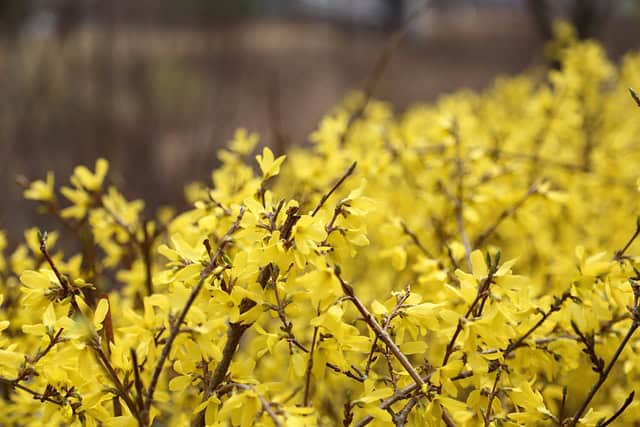
Forsythia is heralded as one of the first signs of spring, with its stunning yellow flowers bursting forth before the leaves emerge. These fast-growing shrubs can reach heights of 3 to 10 feet and are often used to create vibrant hedges or accents in the landscape. Forsythia thrives best in full sun, although it can tolerate partial shade.
After blooming, the flowers give way to green foliage, which provides a lush backdrop as the season progresses. To keep Forsythia looking its best, pruning is recommended after flowering to maintain shape and promote better air circulation within the plant. Their cheerful display and easy maintenance make Forsythia a beloved staple in many gardens.
Hydrangea (Hydrangea spp.)

Hydrangeas are a favorite among many gardeners, often celebrated for their large, showy blooms and versatility. Several types exist, including panicle, mophead, and oakleaf varieties, each offering unique characteristics. Blooming in colors such as blue, pink, white, and purple, these flowering shrubs can brighten up any garden scene.
Hydrangeas flourish best in well-drained soil with adequate moisture and prefer partial shade, although some varieties can handle full sun. Their height can range dramatically, from 3 to 12 feet, depending on the type. With blooming periods often extending from late spring to early fall, Hydrangeas provide long-lasting beauty. Regular pruning after flowering can promote new growth and enhance future blooms. Their engaging blooms make them ideal for both garden landscapes and as stunning cut flowers for arrangements.
Juniper (Juniperus spp.)

While often considered primarily for their evergreen foliage, many Junipers also produce small, inconspicuous flowers. The true appeal lies in their needle-like leaves and rich blue or green color, which can provide year-round structure to your garden. Junipers are exceptionally hardy, thriving in a variety of soil conditions and tolerating drought once established.
Offering a wide range of forms—from low-growing ground covers to tall, upright shrubs—Junipers can fit into any design scheme. Ranging from 1 to 15 feet in height, these adaptable plants can be used as accent plants, hedges, or windbreaks. Minimal care is required, but occasional pruning may be necessary to maintain their shape. The resilience and versatility of Junipers make them a valuable addition to any landscape.
Lilac (Syringa spp.)
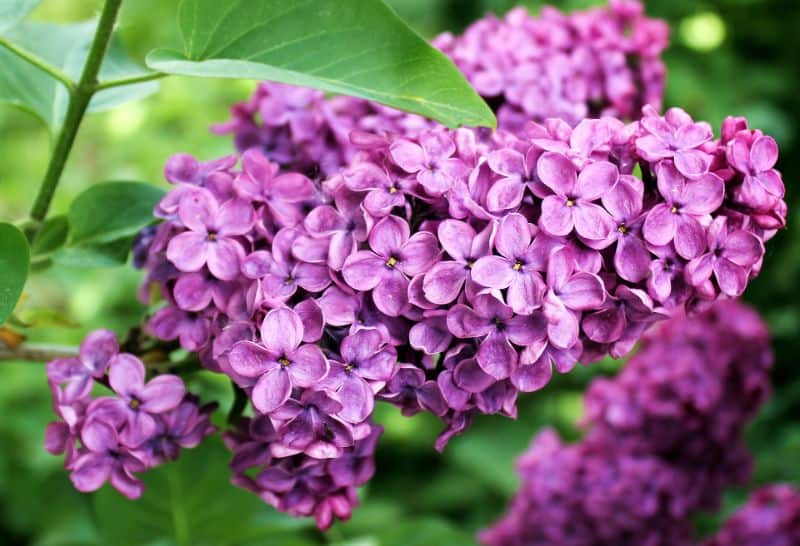
Lilacs are a fragrant garden staple, adored for their immense clusters of small, tubular flowers that bloom in spring. Available in various colors from pale lavender to deep purple, the aromatic flowers can fill your garden with a delightful scent. Lilacs prefer well-drained soil and full sun, often growing between 5 to 15 feet tall.
These deciduous shrubs also provide rich green leaves throughout the growing season and a stunning fall display in some varieties. Regular pruning after flowering encourages new growth and prevents overcrowding, promoting a healthier shrub. Given their timeless charm and sweet fragrance, Lilacs create enchanting focal points in gardens and are often used in cottage-style landscaping.
Mock Orange (Philadelphus spp.)
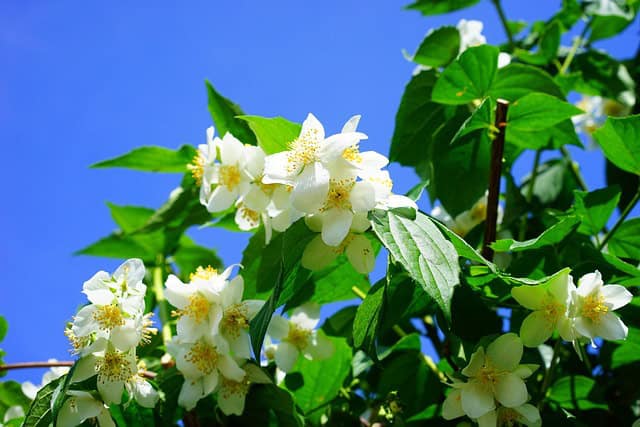
Mock Orange (Philadelphus spp.) is admired for its delightful, citrus-scented flowers that bloom in late spring to early summer. These blooms resemble single or double white flowers scattered across this beautiful shrub. Mock Orange typically grows to a height of 5 to 10 feet and thrives in well-drained soil and full sun.
This deciduous shrub provides green foliage that adds texture to the garden even after the flowering period. They are relatively low maintenance but benefit from an annual pruning after blooming to promote new growth and maintain their shape. Mock Orange is perfect for incorporating a touch of fragrance and charm into borders or mixed gardens.
Ninebark (Physocarpus opulifolius)
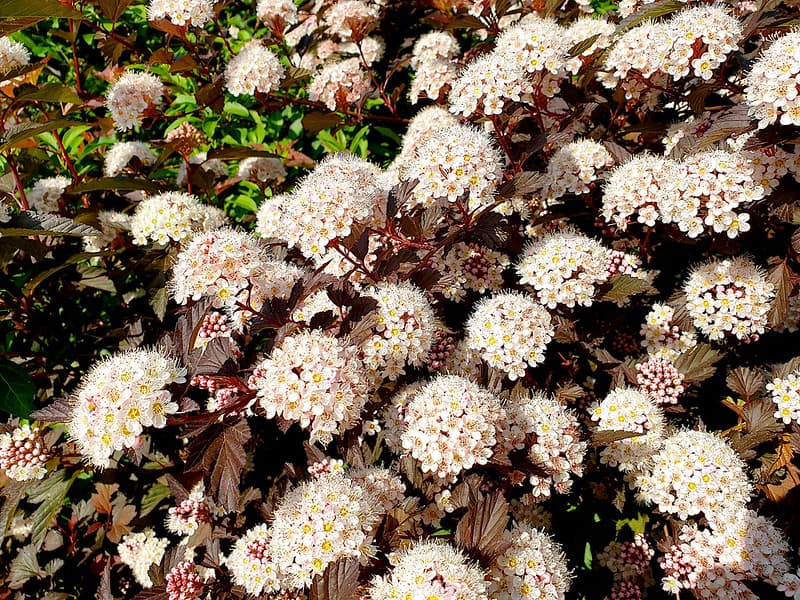
Known for its unique peeling bark and colorful foliage, Ninebark (Physocarpus opulifolius) is an eye-catching shrub that provides multi-season interest. Flowering in late spring and early summer, it produces clusters of white or pink blooms that attract pollinators. Depending on the variety, Ninebark can grow between 3 to 10 feet tall and wide.
This hardy shrub is adaptable to a range of soil types and conditions, thriving in full sun to partial shade. The vibrant foliage varies from green to deep burgundy or golden-yellow, creating striking contrasts in the garden. Regular pruning is advised to maintain healthy growth and an attractive shape. With its unique bark and brilliant blossoms, Ninebark is sure to be a standout in any landscape.
Privet (Ligustrum spp.)
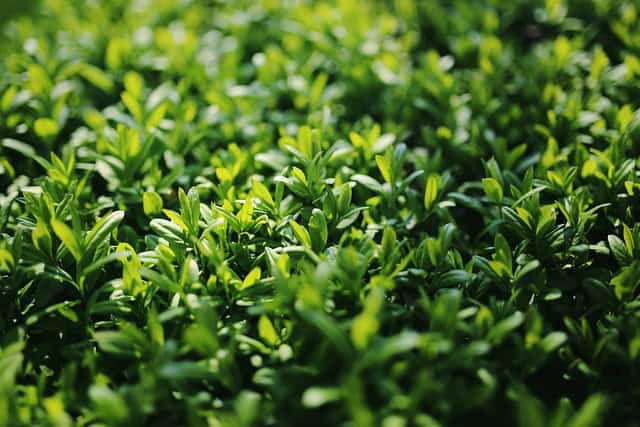
Privets (Ligustrum spp.) are fast-growing deciduous shrubs that are frequently used for hedging and screening. Known for their lush green leaves and small white flowers that bloom in summer, these shrubs can grow up to 10 feet tall, providing effective privacy solutions for outdoor spaces.
Despite their rapid growth, privets are incredibly adaptable, thriving in a variety of soil types and light conditions. Regular pruning helps maintain their shape and promotes denser growth, making them an excellent choice for garden borders or formal hedges. Their ease of care and quick establishment make privets popular among homeowners looking to create immediate landscape impact.
Red Twig Dogwood (Cornus sericea)
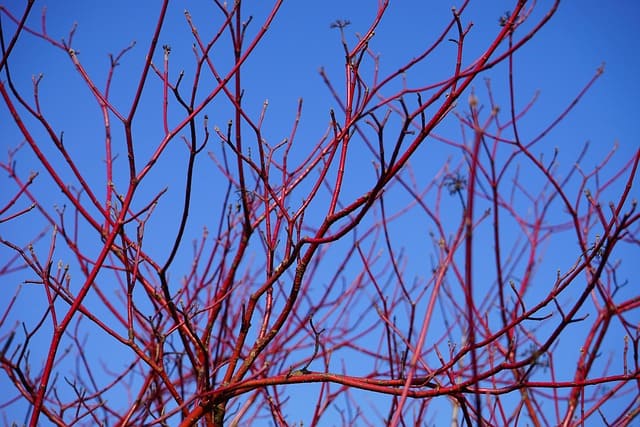
The Red Twig Dogwood (Cornus sericea) is renowned for its vibrant red stems that provide a striking contrast against winter landscapes. This multi-stemmed shrub flowers in spring with clusters of white flowers, followed by white berries. Growing optimally in moist soils and full sun to partial shade, Red Twig Dogwoods generally reach 3 to 9 feet in height.
Incorporating this shrub into your garden provides both seasonal beauty and wildlife benefits, as its berries attract birds. Pruning back one-third of the stems each year encourages vibrant new growth, which enhances the intense color of the stems. Perfect for mixed borders or as a dramatic stand-alone feature, Red Twig Dogwood offers a burst of color during the colder months when many plants are dormant.
Rose of Sharon (Hibiscus syriacus)
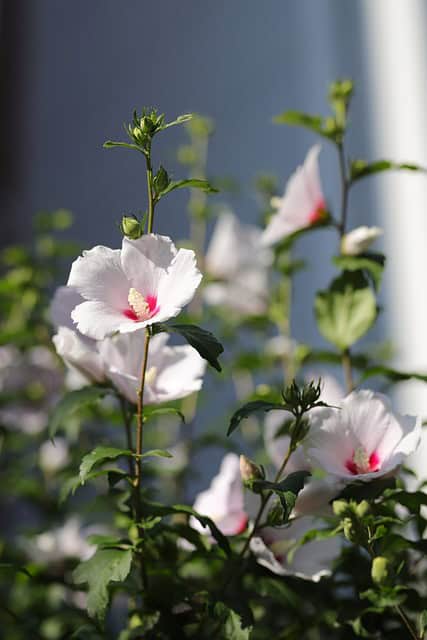
The Rose of Sharon (Hibiscus syriacus) is a unique flowering shrub that blooms in mid-summer, offering large, showy flowers in various colors including purple, pink, white, and blue. Thriving in full sun and well-drained soil, this fast-growing shrub can reach heights of 8 to 10 feet, making it an excellent choice for providing summer color.
Despite its tropical appearance, Rose of Sharon is hardy and adapts well to a variety of garden settings. Its striking blooms attract pollinators and create a dramatic focal point in the landscape. Pruning after flowering helps to maintain a tidy shape and encourages healthy growth. With its abundant blooms and ease of care, the Rose of Sharon enhances summer gardens with its vibrant display.
Weigela (Weigela spp.)
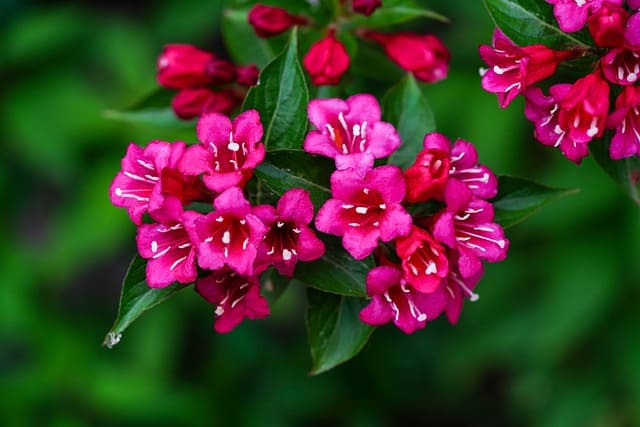
Weigela is a delightful flowering shrub known for its abundant blossoms and reliable growth. Ranging in height from 3 to 6 feet, this shrub produces attractive trumpet-shaped flowers that bloom in shades ranging from pink to red or white, typically from spring through early summer.
Weigela thrives best in full sun and well-drained soil but is tolerant of a range of conditions. Their lush green leaves provide a beautiful backdrop for the colorful flowers and can achieve striking shades of burgundy in some varieties. Light pruning can help shape the shrub and promote vigorous blooms in the following season. With their charming flowers and hardiness, Weigela is a wonderful choice for adding vibrant color to borders, beds, or as accent plants.



